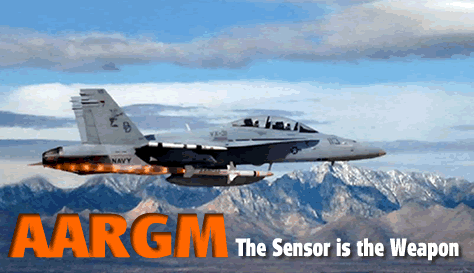An example of a specialized weapon expanding its capabilities to match new and illusive target is the AGM-88 High Speed Anti-Radiation (HARM) missile. This weapons, originally developed to suppress and kill active (emitting) radars, associated with surface-to-air (SAM) missiles and anti-aircraft artillery is being enhanced to assume the role of an active, homing missile designated Advanced Anti-Radiation Guided Missile (AARGM AGM-88E). The primary advantage of the original missile was its range and speed, providing strike fighters supersonic ‘fast kill’ capability when engaging enemy air defenses. Its main drawback was the analog radar homing seeker, which could not ‘memorize’ the target location. Furthermore, the analog seeker homes in on the strongest signal, thus lacking the capability to aim at the target’s most vulnerable spot.
The AARGM upgrade currently in development for the HARM addresses these weaknesses and introduces many additional capabilities transforming the missile into a modern network-enabled weapon. Primarily, the analog RF seeker is replaced by a digital receiver, providing advanced features such as autonomous detection (not dependent on aircraft radar warning receivers) and target recognition (Target ID). The new seeker supports a conformal antenna, clearing the nose cone for a Millimeter Wave (MMW) seeker. With the two seekers AARGM supports ‘blended strike solutions’, implementing INS/GPS for midcourse navigation and active or passive RF techniques for the terminal phase (active MMW or passive RF seeker).
With the new seekers the missile can ‘memorize’ a target signature and location, therefore pursuing the attack even when the target ceases to emit (switched off). It also has the ability to employ a selective aimpoint, by attacking the target’s most vulnerable parts (i.e. the processor) rather than the emitting elements (radar antennae). The weapon’s geolocation capability enables the AARGM to memorize Impact Avoidance Zones (IAZ), eliminating much of the risks of fratricides and collateral damage typically restricting the use of standoff weapons in close proximity to friendly forces or in situations where the risk of collateral damage is too high.
As a fully netted weapon, the AARGM’s uses an Integrated Broadcast Service Receiver (IBS-R) enabling the missile to receive target updates from remote sources, just before launching. AARGM is also equipped with Weapon Impact Assessment (WIA) capability, sending a terminal attack-message burst via satellite, just prior to detonation. WIA provides attack planners with preliminary assessment of the lethal effects employed against planned enemy targets.
The development of the conversion of HARM into AARGM began in 2003 supporting F/A-18A/D, with further support for F/A-18E/F/G, F-35 and EA-6B. Support for Tornado IDS/ECR was introduced in 2005 under a cooperative development agreement between the US and Italy. Germany is also interested in the program. In nine test firings, the missile demonstrated 100% success rate. The program is scheduled for an operational assessment in summer 2008.
Related Topics:
-
AGM-88E AARGM – The Sensor is the Weapon
- APKWS – The Smart Rocket
- A Successor for the Tow, Hellfire and Maverick

















